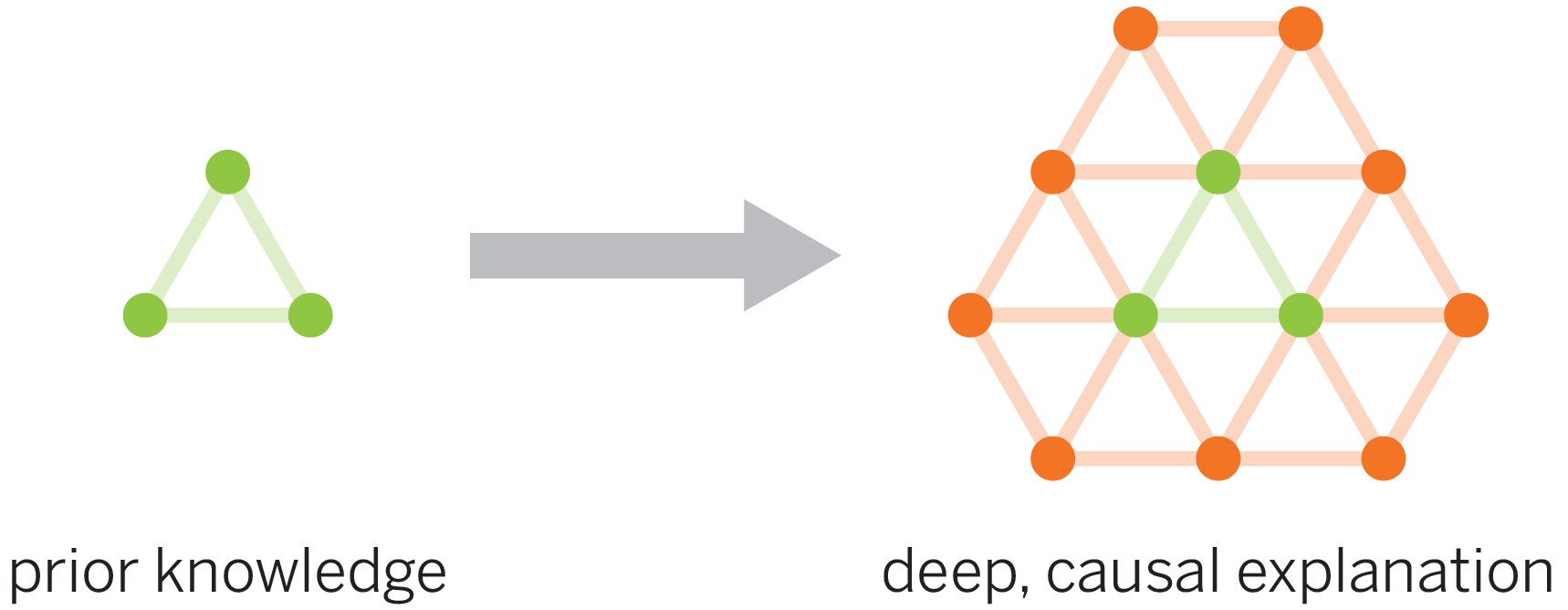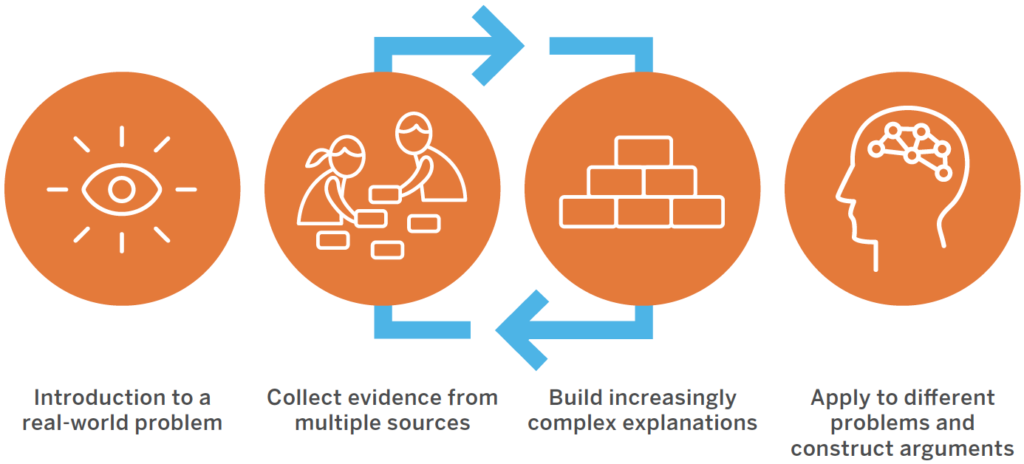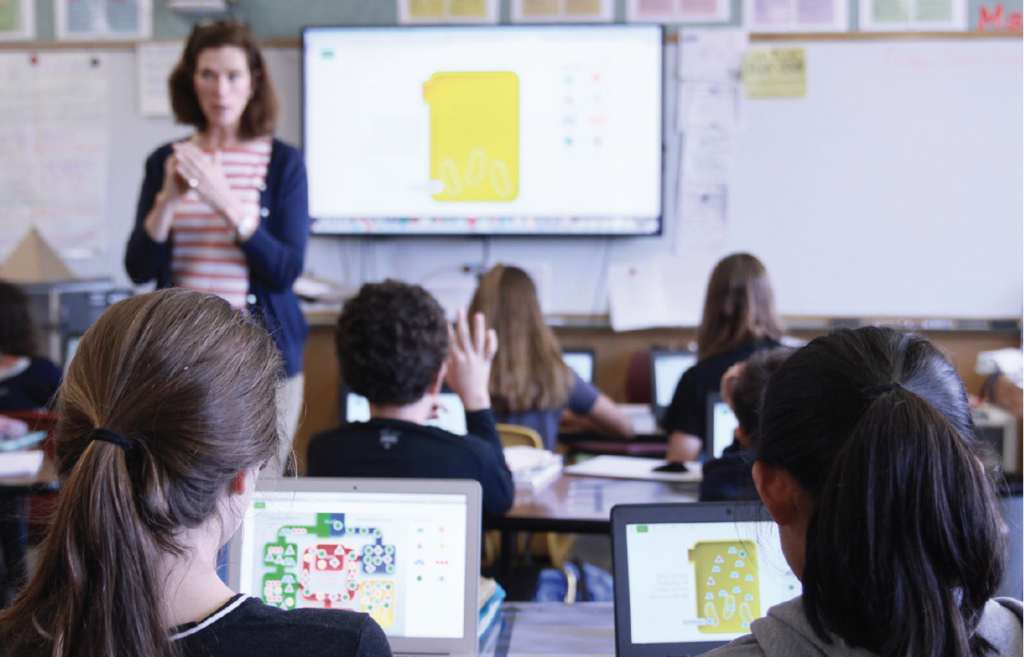Our approach
The Amplify Science approach has students build knowledge across disciplines in each year so that past learning is connected to new concepts, applied to new phenomena, and further developed in each successive year. Hallmarks of the program’s design include its:
- Three dimensional foundation
- Emphasis on unit coherence
- Use of real-world problems and scientific phenomena
- Multimodal approach
- Explicit support for literacy development
- Expanded opportunities to visualize phenomena
1. Designed from the ground up for three-dimensional instruction
The Amplify Science curriculum developers at University of California, Berkeley’s Lawrence Hall of Science crafted each unit, chapter, and lesson with the following questions in mind:
- What do we want students to figure out? (What disciplinary core idea (DCI) or part of a DCI?),
- How do we want them to figure it out? (What scientific and engineering practice will they engage in to figure it out?)
- What crosscutting concept can scaffold students’ understanding and connect it to other ideas about the natural world that they have learned?
This resulted in a curriculum that incorporates a strategic, well-balanced integration of the three dimensions.
2. Emphasis on unit coherence

Student learning experiences and assessments are grounded in a unit-specific learning progression called a Progress Build. A Progress Build clearly defines each level of students’ increasingly sophisticated understanding of unit phenomena students should reach as they progress through the unit. Students build that understanding through engagement with science and engineering practices and application of crosscutting concepts over the course of the lessons in the unit. Thus, as students investigate the anchor phenomena for each unit, they construct new knowledge the way scientists do: through engagement with a core set of professional practices and the application of prior knowledge.
3. Scientific phenomena and real-world problems
In each Amplify Science unit, students are asked to inhabit the role of a scientist or engineer in order to figure out scientific phenomena through a 21st-century, real-world problem context. Over the course of the unit, students collect and make sense of evidence from multiple sources and through a variety of modalities, ensuring that they have multiple vehicles through which to develop and articulate their understanding of each phenomenon. As the class progresses through their lessons, students move back and forth from firsthand investigation and inquiry to secondhand analysis and synthesis, formulating an increasingly complex explanation of the problem at hand. Finally, at the end of the unit, students are presented with a brand-new context to consider, giving them an opportunity to take what they’ve learned over the course of the unit thus far and apply it to this new context, thereby demonstrating a deep understanding of the phenomenon.

Examples of the phenomena-based, real-world contexts students encounter in Amplify Science include:
4. Multimodal approach
 Amplify Science is rooted in the research-based Do, Talk, Read, Write, Visualize model of learning, where students engage with science and engineering practices, figure out disciplinary core ideas, and utilize and apply crosscutting concepts in multiple modalities across thoughtful, structured lessons.
Amplify Science is rooted in the research-based Do, Talk, Read, Write, Visualize model of learning, where students engage with science and engineering practices, figure out disciplinary core ideas, and utilize and apply crosscutting concepts in multiple modalities across thoughtful, structured lessons.
DO: “Do” means collecting firsthand evidence. This can include conducting hands-on investigations, making observations of a video clip, or collecting data using a digital simulation (“sim”), all of which can then be used as evidence in formulating a convincing scientific argument.
TALK: Student-to-student discourse is a key indicator of a productive learning environment, and talking is a key modality for instruction in an Amplify Science class. This is more than just partner activities or group work—though there’s plenty of that, too. For example, reading activities are followed by a student-to-student discussion where students share their insights and questions with each other and with the whole class. Through talking and developing a collaborative environment, students feel comfortable asking questions of one another, challenging assumptions, and learning from each other.
READ: Student texts, all written by the Lawrence Hall of Science, serve multiple purposes: They help students make connections between science concepts and additional real-world contexts; provide students with data to analyze; model science practices; and show real scientists in action. Students also learn to read actively, with explicit instruction on how to record their questions, seek evidence from text, and monitor their understanding as they read.
WRITE: Students in Amplify Science have frequent opportunities to write in order to help them reflect on and make sense of what they are learning. Across the program students learn how to express their scientific thinking by leveraging evidence and using relevant vocabulary as they apply their thinking to writing. Frequent reflective writing helps students to gain a deepening understanding of the genres of scientific arguments and explanations, both of which embody the foundation of scientific understanding and expression.
VISUALIZE: Through a combination of simulations, media, hands-on activities, readings, and digital and physical models, students are empowered to visualize scientific phenomena in ways never possible before.
6. Expanding opportunities for visualizing

Through the thoughtful integration of cutting-edge technology, students of Amplify Science are empowered to visualize otherwise invisible scientific phenomena in new and exciting ways. Students have the ability to use technology in ways that real scientists and engineers would. For example, by visualizing sound waves traveling through the air in the grade 4 Sound Waves Simulation, and by studying solubility at the nanoscale in the grade 5 Modeling Matter Simulation, students have the ability to use technology in ways that real scientists and engineering would.